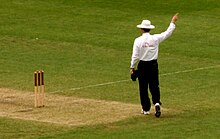Batting
At any one time, there are two batsmen in the playing area. One takes station at the striker's end to defend the wicket as above and to score runs if possible. His partner, the non-striker, is at the end where the bowler is operating.
Batsmen come in to bat in a batting order, decided by the team captain. The first two batsmen – the "openers" – usually face the hostile bowling from fresh fast bowlers with a new ball. The top batting positions are usually given to the most competent batsmen in the team, and the non-batsmen typically bat last. The pre-announced batting order is not mandatory and when a wicket falls any player who has not yet batted may be sent in next.
If a batsman "retires" (usually due to injury) and cannot return, he is actually "not out" and his retirement does not count as a dismissal, though in effect he has been dismissed because his innings is over. Substitute batsmen are not allowed.
A skilled batsman can use a wide array of "shots" or "strokes" in both defensive and attacking mode. The idea is to hit the ball to best effect with the flat surface of the bat's blade. If the ball touches the side of the bat it is called an "edge". Batsmen do not always seek to hit the ball as hard as possible, and a good player can score runs just by making a deft stroke with a turn of the wrists or by simply "blocking" the ball but directing it away from fielders so that he has time to take a run.
There is a wide variety of shots played in cricket. The batsman's repertoire includes strokes named according to the style of swing and the direction aimed: e.g., "cut", "drive", "hook", "pull".
Note that a batsman does not have to play a shot and can "leave" the ball to go through to the wicketkeeper, providing he thinks it will not hit his wicket. Equally, he does not have to attempt a run when he hits the ball with his bat. He can deliberately use his leg to block the ball and thereby "pad it away" but this is risky because of the leg before wicket rule.
In the event of an injured batsman being fit to bat but not to run, the umpires and the fielding captain may allow another member of the batting side to be a runner. The runner's only task is to run between the wickets instead of the injured batsman. The runner is required to wear and carry exactly the same equipment as the incapacitated batsman. It is possible for both batsmen to have runners.



